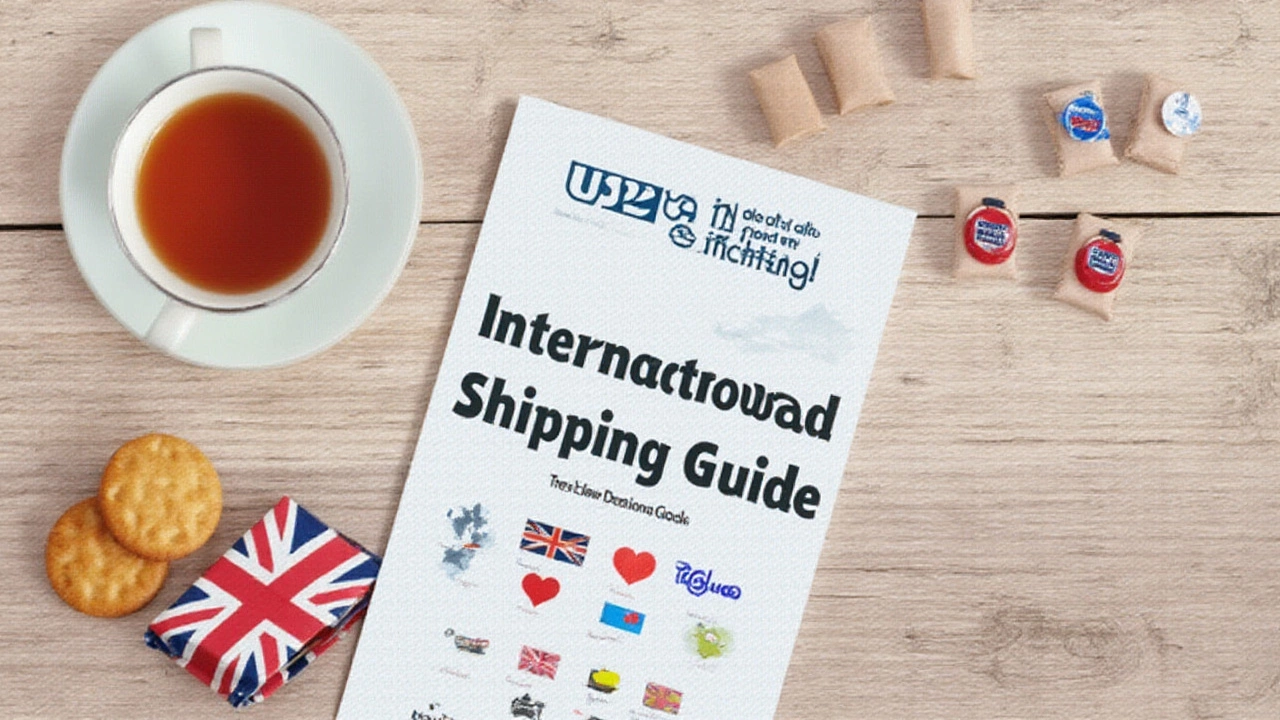Shipping a package overseas might seem like a daunting task, but with the right information, it can become a lot simpler. USPS, the United States Postal Service, offers several options for sending parcels internationally, catering to different needs and budgets.
While deciding which service to use, it's important to consider factors like the cost, delivery time, and service reliability. Let's explore these options and see how you can calculate the costs involved and even pick up a few handy tips to save money along the way.
- Introduction to USPS International Shipping
- Factors Affecting Shipping Costs
- Different USPS Overseas Shipping Options
- How to Estimate Shipping Costs
- Tips for Reducing Shipping Expenses
- Common Mistakes to Avoid When Shipping Overseas
Introduction to USPS International Shipping
Sending packages overseas is a necessity for many of us, whether for personal reasons like sending gifts to family and friends or for professional purposes such as fulfilling international orders. The United States Postal Service, commonly known as USPS, is a trusted government-operated entity that offers a range of international shipping solutions tailored to various needs. With a vast network covering over 190 countries, USPS facilitates the seamless transit of parcels across borders while maintaining a commitment to efficiency and affordability.
USPS offers several shipping services for international delivery, each differing in speed, cost, and level of service. Some popular choices include Global Express Guaranteed, Priority Mail Express International, and Priority Mail International. Global Express Guaranteed promises the fastest delivery, typically within one to three business days, which is perfect for time-sensitive shipments. Priority Mail Express International delivers within three to five business days and offers the benefit of tracking for additional security. Many customers find Priority Mail International an attractive option; it strikes a balance between cost and speed, with delivery ranging from six to ten business days.
The cost of shipping with USPS overseas can depend on several factors, including the destination, weight, and dimensions of the package. For instance, larger and heavier packages generally cost more to ship than smaller ones. USPS uses a zoning system to calculate prices, whereby countries are grouped into zones, each assigned distinct rate brackets. This tiered pricing helps keep costs transparent and easy to estimate. Shipping experts at USPS suggest that customers use their online price calculator to gauge potential costs before heading to the post office.
It's interesting to note how USPS has evolved its international shipping strategies over the years. According to a spokesperson from USPS, "The ability to send packages internationally provides our customers with significant flexibility and reach. We've continuously adapted our services to better meet the needs of our growing international user base." This adaptation includes improvements in technology and logistics that enhance the overall shipping experience.
Another facet of USPS international shipping is customs. Packages that cross international borders are subject to customs regulations and taxes. While this might sound complicated, USPS streamlines the process by providing detailed customs guidance and necessary forms, which customers can fill out online. This preparation ensures minimal delays during shipping. Understanding these customs requirements beforehand can significantly fast-track the delivery process and reduce unforeseen costs associated with shipping delays.
Whether you're a business owner sending products to international customers or someone mailing a package to a loved one across the sea, the USPS is a valuable resource. Taking advantage of the diverse options and services they offer can simplify what might otherwise be a daunting task. Stay tuned as we delve deeper into the factors affecting shipping costs and reveal expert tips to save both time and money.
Factors Affecting Shipping Costs
When delving into the world of *USPS* international shipping, you'll find that several variables can play significant roles in determining the cost of sending packages overseas. To start with, the weight of your package is one of the most critical factors. Heavier packages will naturally incur more charges, so it's advisable to weigh your items before deciding on the packaging to avoid unnecessary expenses. Similarly, the dimensions of your package can affect the price. Dimensional weight pricing means that big, lightweight packages can be charged more than you might expect based on size alone. Being mindful of how you pack can save both money and space.
Another crucial element is the destination. The farther away the country, often the more costly the shipment. USPS organizes countries into zones, which helps standardize and simplify the pricing. However, it's essential to understand these zones and check where your package falls. This can prevent any surprise costs and help with budgeting your shipping needs appropriately. Additionally, the choice of service level — whether it's Priority Mail, First-Class Package, or Global Express Guaranteed — influences the price. Each service comes with different speed and reliability guarantees, which also affects costs.
An insightful aspect to consider is the inclusion of insurance and additional tracking options. While standard services often include some tracking, opting for more detailed tracking or extra insurance can raise your costs. However, these additional services might save you headaches down the line, especially if you're dealing with high-value or irreplaceable items. Mike Easton, a logistics specialist, once noted,
"Choosing the right balance of speed, security, and cost is crucial in international shipping. Cheaper isn't always better when you're looking to build trust with your international customers."These supplemental costs are worth evaluating based on the nature of the goods and customer expectations.
Furthermore, customs fees and duties are external costs to consider. These are not directly related to USPS charges but are mandated by the destination country's laws. It's not uncommon for recipients to bear these costs, although it’s wise to inform them ahead of time. Some countries have specific tariffs and customs arrangements with the US, which could impact the fees differently. Keeping abreast of these can prevent delays and dissatisfaction.
Finally, a seasonal factor sometimes forgotten is the pricing fluctuations during festive periods or peak seasons like Christmas or Black Friday. High demand can strain transportation resources and lead to surcharge implementations, indirectly affecting your USPS shipping costs. Planning early can help shield you from these temporary hikes. USPS often announces these surcharges in advance, providing businesses ample time to strategize.
A detailed look can reveal a lot, and gaining a comprehensive understanding of how each of these components affects the cost can arm you with the knowledge to make smarter shipping decisions. For businesses, this understanding is not only an operational necessity but also a way to improve customer satisfaction by setting realistic expectations and adhering to them. International shipping doesn't have to be an intimidating prospect, and by taking the time to understand these factors, you can tackle worldwide markets efficiently.

Different USPS Overseas Shipping Options
When it comes to sending your letters and packages across the globe, the USPS presents a few choices tailored to various needs. Whether you're in a rush to get something there quickly or you have a bit of time, and are looking to save a few bucks, there's an option for everyone. The USPS aims to make international shipping as straightforward as possible, which can be a relief for anyone new to the process. Knowing the available services can not only prevent any confusion but also help in making a more budget-friendly choice.
To begin with, USPS Priority Mail International is a popular option that balances speed and cost. Most packages sent through this service can reach over 190 countries within 6 to 10 business days. Not only is tracking and insurance included, but flat-rate pricing for certain sizes makes it a predictable option. If you're looking for the cheaper cousin, First-Class Package International Service might be the answer. This service is an economical way to send lightweight packages up to four pounds, though it might take longer, and tracking isn't available for all destinations. For those who value speed above all, USPS Priority Mail Express International ensures delivery to most locations in just 3 to 5 business days, complete with a money-back guarantee to select countries.
When it comes to something extraordinary or a bit more personalized, there's USPS Global Express Guaranteed, the fastest option for over 180 countries with estimated delivery times of 1 to 3 business days. It entails a partnership with FedEx, offering even more precision. This top-shelf service does come with a higher price tag, but for urgent or highly valuable items, it's often worth considering. The USPS also provides a range of customs declaration forms and guidelines to streamline the international shipping process, helping ensure your package doesn't get held up at borders. As illustrated in a customer review, "USPS Global Express Guaranteed has been my go-to for ensuring critical documents arrive swiftly and safely," echoes the sentiment of many satisfied users worldwide.
Also, tariffs and package contents could affect the additional charges, so it's wise to be prepared with the necessary documentation. The USPS website offers a handy postage calculator to give you an idea of potential costs before you head to the post office, which can be a real time-saver. As always, thinking ahead can help avoid unexpected fees or delays, ensuring your package arrives at its destination as intended.
How to Estimate Shipping Costs
When you're planning to send a package overseas, estimating shipping costs accurately can save you both money and headaches. The first thing you'll need is a clear understanding of what influences the cost of shipping with USPS. These factors include the destination, the dimensions and weight of the package, and the type of shipping service you choose. With USPS, the main services for international shipping are First-Class Package International Service, Priority Mail International, and Priority Mail Express International, each varying in speed and price.
One useful tool for calculating shipping costs is the USPS Postage Price Calculator, available on their official website. This calculator is a great starting point as it allows you to enter specifics about your package, such as its weight and destination, to provide you with a cost estimate. It's important to weigh your package accurately using a household scale or a more precise postal scale. Then, measure the length, width, and height and provide these details in the calculator to ensure the most accurate estimate.
The USPS international shipping rates depend significantly on the weight of your package. For instance, smaller items like documents or lightweight parcels might benefit from the less expensive First-Class Package International Service, which offers lower rates for items under four pounds. For packages that are heavier or if you prefer faster delivery, opting for Priority Mail or Priority Mail Express services might be more suitable. Depending on your choice, your costs and delivery times will vary. Priority Mail flat rate boxes provide a good option for sending larger quantities without worrying about weight limitations as long as items fit in the box.
Be mindful of additional costs such as insurance and tracking, which might be necessary for valuable items. Adding these services will increase the final shipping cost but also provide peace of mind. Additionally, certain destinations may levy customs duties or taxes on incoming packages, which can surprise many first-time shippers. These charges are typically the recipient's responsibility, but understanding them can help set realistic expectations. If you'd like to see the shipping times and cost variety, you might even consult a sample table that compares the costs and delivery estimates of different USPS services to popular international destinations.
“Knowing the exact dimensions and weight of your package helps avoid unexpected fees at the post office,” says Michael Thompson, a logistics expert and author of ‘Navigating the International Mail.”
Lastly, USPS offers various resources and guides, both online and at their local offices, aimed at helping customers navigate international mailing more efficiently. Make sure to double-check the shipping restrictions for certain countries as some goods may be prohibited or require special handling. By gathering and analyzing all these pieces of information, you'll be well-prepared to estimate and manage your shipping costs efficiently.

Tips for Reducing Shipping Expenses
When it comes to international shipping, there are several savvy strategies to help minimize expenses without compromising on the service quality. One of the golden rules is to always be aware of your package's dimensions and weight. The USPS costs can vary significantly based on these two factors. To make sure you are not paying more than necessary, invest in a reliable scale and measuring tape for your home or office. Weigh your package and compare it against USPS shipping guidelines. Keeping the packaging as compact and lightweight as possible can help achieve substantial savings, especially when dealing with larger shipments.
Another useful tip is to explore the various shipping options offered by USPS. Priority Mail International may be faster, but if time is not of the essence, the International First-Class Package is often more economical. For businesses or frequent shippers, exploring discounted rates through third-party shipping platforms or considering a business account with USPS can lead to reduced costs in the long run. These platforms can offer price comparisons and cheaper deals due to their partnerships with mailing services. It can streamline the shipping process and ensure you get the best rate for your parcel.
Most people overlook the importance of packing materials in determining shipping costs. Opting for lightweight materials and keeping the items secured yet unburdensome will make a significant difference in the total shipping fee. If you are reusing boxes, make sure that they are in good condition and not oversized compared to the contents. In tracking trends, an impressive fact shared by the Pitney Bowes Shipping Index reveals that 40% of businesses identified packaging reductions as a key driver in saving on shipping costs, which advocates the importance of thoughtful packing.
Consider the timing of your shipments too. Shipping during off-peak times can sometimes lead to better rates. While peak seasons can’t always be avoided, planning your shipments in advance can gift you lower costs. Although it might seem insignificant, comparison shopping is crucial. Different countries can have varying tariffs, and services might offer promotions that align with your needs. Staying updated on these trends allows you to take advantage of the best offers available.
"We found that reducing package weight by even a few ounces and utilizing the smallest possible box size cut our shipping budget by 20%," notes Janet Smith, a manager at the logistics firm ShipSmart.Don't hesitate to contact your local USPS office or visit their website to stay informed about any possible adjustments in their rates or guidelines. Being well-prepared and informed about the shipping industry's nuances is half the battle won when aiming to cost-effectively manage international posting. Keep tinkering with these strategies, and watch as the savings start to add up, leaving you more resources to innovate and grow.
Common Mistakes to Avoid When Shipping Overseas
Sending packages across borders involves more than just dropping them off at the USPS counter. A frequent blunder many make is neglecting to thoroughly double-check the shipping address. It's vital to ensure the address is correctly formatted according to the destination's guidelines; a small mistake could result in costly delays or returns, adding unexpected expenses to your shipping budget. Also, it’s crucial to verify and understand these intricacies to avoid falling into the trap of unnecessary rework and ensure your package reaches its destination without a hitch.
Another common error is underestimating the importance of accurate weight and size measurements. USPS calculates international shipping costs based significantly on these factors. If your package measurements are off, you might end up paying more than you should, or worse, face delays if the shipping label's postage is insufficient. Invest a few extra minutes to weigh and measure packages accurately, which can save a lot of trouble later on. A small digital scale and a measuring tape can become your best friends in preventing this mistake and ensuring your experience with USPS remains smooth.
Proper documentation is yet another area where shippers often falter. Every country has its own peculiar customs regulations, and failing to comply or provide incomplete information can lead to shipments being held at customs, or worse, returned to the sender. This often-overlooked step of filling out customs forms diligently and including all necessary details cannot be stressed too much. Depending on the destination, additional documents might be needed, so research thoroughly and check twice before sending out that package.
"Your package is only as fast as the slowest customs office it passes through." - Unknown
Inadequate insurance coverage is a risk that's also commonly overlooked. Many assume their package will automatically be insured by USPS, but that's not always the case. It's important to assess the value of what you're shipping and decide if purchasing additional insurance is worth the peace of mind. This is particularly crucial for valuable or irreplaceable items. Making sure you've got the right amount of coverage can safeguard against financial loss should the unexpected happen.
Lastly, failing to account for local holidays in the destination country can lead to delays or misdeliveries that could otherwise be avoided. Understanding not just your own timeline but also the recipient's local context is critical in ensuring a timely delivery. Consulting a calendar of public holidays might help navigate your package through these potential roadblocks. The world of shipping is indeed a complex one, but being armed with the right knowledge and forethought can make a significant difference to your overall experience.


